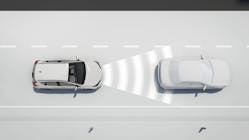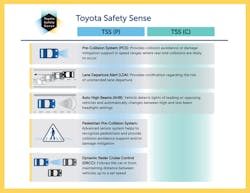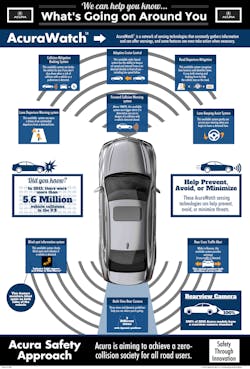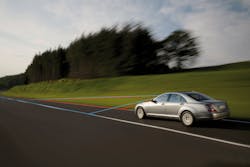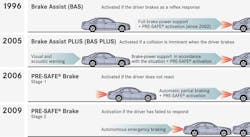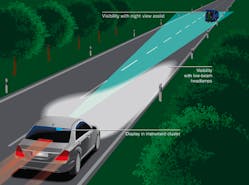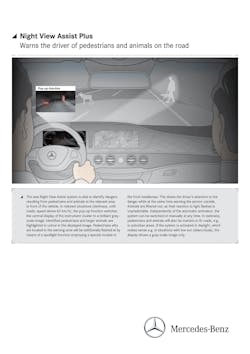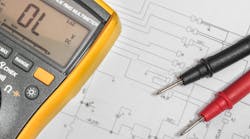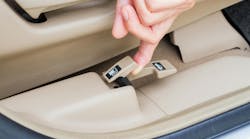While collision avoidance systems are becoming somewhat of a buzz word lately they really aren’t all that new. In fact, General Motors acquired Hughes Aircraft Corporation back in 1985 in part to accelerate their development of collision avoidance systems. General Motors continued progress with the systems and eventually participated in a joint project with the National Highway Traffic Safety Administration (NHTSA) which ran from 1999-2004 to further refine and finally launch their first system which was installed on a limited number of the model year 2002 Buick LeSabre for real world testing.
Some of the technology used in collision avoidance systems is in essence a limited version of autonomous vehicle technology. The most common type of these systems currently being implemented is automated cruise control. These systems are not new either really; in fact these were introduced years before the GM/NHTSA collision avoidance project. Early versions of laser based automated cruise systems were introduced to the Japanese market in the early to mid-1990s by both Mitsubishi and Toyota. That was then followed by the first worldwide launch of a radar based system on the Mercedes Benz S class around 1999 which included the US market.
The number and complexity of these types systems obviously prevents this article from covering them all. Instead I’ll focus on a few main types of systems that may impact how your shop handles even “basic” services such as brakes, tires and alignments.
Automated cruise control
As I just mentioned, Automated Cruise Control systems are not exactly new. That being said however, they are beginning to become much more common so the chances of you needing to deal with them are increasing almost daily. The basic concept with these systems is to help reduce the amount of driver input required once cruise control is enabled. The actual amount of assistance the vehicle provides however can vary widely. In the most basic systems that were first introduced the driver was simply provided with a warning that they were approaching a vehicle that was moving slower. That progressed fairly rapidly to include a limited control system that would adjust the throttle in an attempt to adjust pace to the other vehicle but didn’t include active braking. Today we can see any realm of these systems all the way up to the soon to be released GM “Super Cruise” (Super Cruise is the working name GM is using for their automated driving systems). The Super Cruise system is capable of not only pacing the vehicle to other cars (all the way to a complete stop if necessary), it can also keep the vehicle in its own lane through steering assist. That system was expected to be released in late 2016 however it has now been pushed to sometime during 2017 with the first introduction expected to be on the Cadillac CT6. While it has been delayed, GM promises the technology is very close to production.
So, how might automated cruise control affect what you do every day? Probably the most likely impact will be if you perform alignments. I was working as a Mercedes Benz dealership technician when their first Distronic radar paced cruise control entered the US Market in 1999. The dealership was required to replace their alignment equipment at that point to ensure the system being used was accurate enough to maintain the required tolerances (and the system we took out wasn’t exactly old). You might be asking yourself how alignment could impact a cruise control system. With virtually all of these systems there are radar and/or laser sensors involved. Those sensors are typically mounted toward the front center of the vehicle (radiator core support area) and face forward. The goal of the sensors is to watch for other vehicles in front of, and in the same lane as, the vehicle being driven. The key part to that at it relates to alignments is that it watches for vehicles in the same lane. With the sensor(s) being mounted to the body, if the vehicle is “dog tracking” due to poor alignment the sensor(s) may not be looking directly forward. Dog tracking is caused by the vehicle’s thrust angle being incorrect. The incorrect thrust angle results in the rear wheels pushing the vehicle off to one side or the other. To keep the vehicle going straight down the road the driver then corrects by turning the front wheels until they are virtually parallel to the rear wheels which would cause the steering wheel to be off center. If a two-wheel (front wheel) alignment is performed without correcting the thrust angle everything could look correct to the driver (steering wheel straight, no pulling, etc.), but the automated cruise sensors could be pointing too far off to one side. That means either the thrust angle would need to be corrected, or the alignment of the sensor would need to be adjusted to correct for the thrust angle in order for the system to work as designed.
Electronic Stability Control
Electronic Stability Control (ESC, also referred to as EPS or DSC) has been required on vehicles in the US market since model year 2012. Even with 5 years of full implementation (and numerous more years of limited implementation before that) the amount of technician knowledge on these systems still seems lacking at times. As a refresher, these systems were primarily implemented to help reduce rollover accidents. They do this by controlling the braking of individual wheels if vehicle is beginning to skid. Of course, that means the vehicle needs to make very fast decisions about which brake(s) to apply, and how hard to apply them. To support those decisions the vehicles have been equipped with additional sensors such as YAW rate sensors and steering wheel angle sensors. The YAW rate sensor monitors the vehicle’s “sideways” acceleration (G force). It’s important to ensure these sensors are mounted in the correct orientation when installed in the vehicle and that they are torqued properly to avoid any potential erroneous/inaccurate data. The steering wheel angle sensor is used to provide input about how fast the steering wheel is being turned, in which direction, and the relation to center. The relationship to center is the part that is likely to affect your servicing of the vehicle the most frequently. Much like the cruise control systems mentioned above need to have thrust angles correct to function properly, the steering wheel angle sensor needs to be calibrated after an alignment. This ensures that what the vehicle recognizes as “center” for the steering wheel correlates to when the vehicle is actually driving straight forward. Without that calibration being performed the ESC could potentially apply the wrong brake(s) during a skid. The calibration typically requires a scan tool and can include a fairly lengthy process. Some of the newer alignment systems, such as the Hunter HawkEye Elite, however are starting to build some of this steering angle recalibration (and even some of the cruise control sensor alignment functions) into their software. That likely will prove to be a very large time saver if you do a large number of alignments on late model vehicles.
Collision Avoidance Systems
Collision Avoidance Systems is currently a pretty broad range of technologies, and that range is really still expanding. Some of the more common ones that are being implemented involve various ways to keep a vehicle in its own lane (either passively or actively) and provided automated or assisted emergency braking. The driving force behind these systems is the fact that most motor vehicle crashes are tied to human choice or error. In fact, the NHTSA estimated that in 2015 that human error or choice accounted for around 94 percent of all vehicle crashes.
Lane departure systems can be a warning only system that lets the driver know they are about to leave the lane, or a more active system that will actually help keep the vehicle within the lane. Both types of these systems rely on at least one camera to monitor the lane position. It’s important to have awareness of these systems and the locations of the camera(s) on vehicles you are working on. Because the systems rely on input from those cameras anything you do that could impact the view those cameras have could cause the system to not work correctly. For windshield-mounted cameras that could be something as simple as putting on the incorrect length wiper blade. If the camera is mounted up high behind the windshield a shorter wiper blade could prevent the area in front of the camera from being cleared and/or cleaned when the wipers are activated. Another fairly common repair that you likely sublet out, if you do them at all, is windshield glass replacement. If you offer to have that service performed on these vehicles you need to be aware of the OEM requirements and any additional steps you may need to perform that the glass companies typically don’t do. For instance, Honda has a Parts TSB (that’s right, Parts not Service) that specifically warns about using non OEM glass in any of their vehicles with a forward facing camera mounted behind the windshield. The concern is that any other glass brand may not allow the camera to be focused properly since after all, the windshield is more or less serving as a second lens for the camera. And even if the correct glass is installed, it’s highly likely these systems will all require some type of recalibration procedure that will almost definitely require a capable scan tool. If that recalibration isn’t done, or an incorrect type of glass is used, it likely won’t set a code right away. It could however impact the performance of the system and result in driver complaints that may take a lot of time to chase down (erratic lane departure warnings, etc.). The more advanced lane keeping systems simply take it a step further. They process the input from the lane departure system and then act on the data provided to keep the vehicle in its lane. This can be accomplished through selective wheel braking, steering assist, etc. Ensuring all related systems on the vehicle are operating properly is critical to the operation of the safety system.
Active braking is another collision avoidance system with a wide range of implementation methods. As with many of the other systems, this isn’t really a new concept but rather one that is being implemented much more broadly and is becoming more capable. Mercedes Benz actually introduced their BAS (Brake Assist System) back in 1996. That system would activate if a driver applied the brakes in a method that appeared to be a panic braking event. It would then apply additional braking force to help bring the vehicle to a stop as rapidly as possible if the driver wasn’t pushing hard enough on the pedal. Systems have since progressed to provide warnings to the driver (audible and/or visual), and even systems that will apply the brakes without driver input if the driver doesn’t respond to the warnings.
So, how do these braking systems potentially impact your service of the vehicles? For the most part it’s not a lot different from taking care of a traditional braking system. It’s important to ensure the core braking system is working properly. That means you also need to consider the quality and construction of braking components you are using to service vehicles. The systems are designed to operate properly given the OEM specified brakes. Consider the possible implications if you install brake pads that are not the same type and/or quality of the OEM pads. A low-cost alternative that may not provide the same stopping power could mean the system doesn’t function to its full capability. Alternatively, an “upgraded” performance set of brake pads that actually grips the rotors more aggressively could possibly cause wheels to lock up which may decrease the effectiveness of the automated braking systems as much, or more than, a set of “weaker” brake pads. There’s definitely nothing wrong with using aftermarket parts, just be sure they meet the OEM specifications.
None of these new technologies will drastically change what you do on a daily basis; however it does reinforce a few key things that I feel all shop owners need to maintain focus on at all times:
-
Ensure your staff is continually attending update training
- Don’t limit this just to your technicians, your service advisors also need to have a working knowledge of these systems to be able to explain what is needed to your customers
-
Ensure you have access to high quality service information
- OEM service information is ideal to ensure accuracy on the latest models/technology
- If using aftermarket service information I prefer to have two or more sources available as a way to cross check the information if/when needed
-
Ensure your equipment is kept up to date
- Whether it’s scan tools, alignment equipment, etc. be sure you have the required tools to effectively service any vehicles you are taking in
